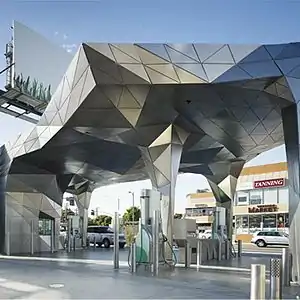Helios House
The Helios House is a gas station in Los Angeles, located on Olympic Boulevard. It is designed as a green station with special features and is considered to be the "station of the future." It is the first gas station in the United States to be submitted for LEED certification.[1][2][3]


The gas station was designed by Office dA (Principal architects Monica Ponce de Leon and Nader Tehrani) in Boston and Johnston Marklee Architects in Los Angeles.[4] The architects were hired by Ogilvy & Mather, led by Brian Collins. The purpose of the design was to reinvent the gas station.[5]
The station's roof is designed of triangles made from recycled stainless steel and contains cacti and 90 solar panels.[6] This reduces the energy consumption of the station by 16%.[7] The station's roof is drought tolerant and collects water for irrigation.[8]
Built in 2007, it is seen as a Los Angeles landmark. It started out selling BP branded gasoline, but in 2010 switched to ARCO.
Features of the station
Structural
- Made of cradle to cradle recyclable stainless steel[9]
- Farmed wood facade[9]
- CO2 reducing landscaping[9]
- Grass planted on roof to reduce the need for mechanical heating or cooling[9]
- Catch basin prevents runoff into ocean [9]
- Canopy collects rainwater used for on-site irrigation and to meet station's water needs[9]
- LOW-VOC paint used in back of building[9]
- Signage made from recycled material[9]
Energy saving
- Canopy lighting uses up to 20% less energy than traditional gas stations [9]
- LED lighting throughout the station, using low amounts of energy to achieve the same brightness [9]
- Roof contains 90 solar panels, which can produce the energy needed for 2-3 average American homes[9]
- Photocells and timers help customize energy needs to time of day and amount of light[9]
Restroom features
- Walls made from farmed wood and rapidly renewing bamboo[9]
- Motion sensor lights, reducing energy waste when not in use[9]
- Bathroom sinks are made out of recycled aluminum shavings[9]
- Floor tiles made from recycled glass[9]
- Low water volume faucets, which shut off automatically when not in use to prevent water waste[9]
References
- McCann, Sarah More (July 10, 2008). "BP creates a greener place to pump gas". The Christian Science Monitor.
- Douglass, Elizabeth (February 23, 2007). "Paradox at the pump: BP touts new gas station as eco-friendly". Amarillo Globe-News.
- Gibson, David. The wayfinding handbook: information design for public places. p. 71.
- http://www.architectmagazine.com/architects/office-da.aspx
- Stone, Terry Lee. Managing the Design Process Implementing Design: An Essential Manual for the ... pp. 33–34.
- Kossovsky, Nir. Mission: Intangible: Managing Risk and Reputation to Create Enterprise Value. p. 132.
- Jodidio, Philip. Architecture and Automobiles. Los Angeles. p. 98.
- Sokol, David (August 10, 2007). "Green Gas Stations: Pit stops dishing out biofuel and ethanol are adopting sustainable architecture to show they're green through and through". Bloomberg Businessweek. Archived from the original on May 19, 2008.
- http://www.bp.com/liveassets/bp_internet/power_station/power_station_us/STAGING/local_assets/downloads/greencurvestation.pdf